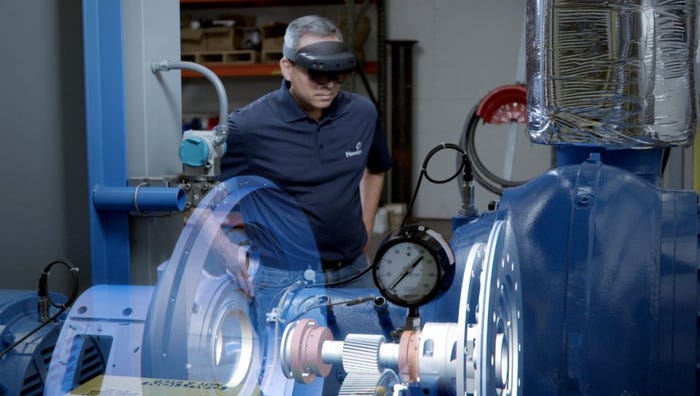Microsoft and PTC Highlight Industrial HoloLens 2 AR Projects
At MWC, the two companies highlighted pragmatic industrial and enterprise use cases of the new HoloLens headset.
February 26, 2019

“When you change the way the way you see the world, you change the world you see.” —Microsoft CEO Satya Nadella at MWC
Mixed reality and augmented reality may be enormously powerful concepts, but there have been few demos that capture the technologies’ potential to offer new immersive experiences. “Better and more transparent hardware, coupled with more compelling use cases, is needed before further progress can be made [in augmented reality],” concluded Gartner last year.
The situation may have changed with the launch of the HoloLens 2, which represents a considerable upgrade over the previous version of the AR headset that launched four years ago. “This new medium is just the beginning of experiencing what’s possible,” Microsoft CEO Satya Nadella said in an MWC keynote unveiling the device, which represents a considerable upgrade over the prior version.
Aimed squarely at enterprise, medical and industrial audiences, the HoloLens 2 has a $3,500 price tag that Microsoft anticipates its customers will accept given the technology’s instructional capabilities and revamped hardware. The field of display on the device is considerably larger than its predecessor, the ergonomics and visual display improved. The HoloLens 2 also tracks a user’s hands and eyes (and supports retinal authentication).

Microsoft is also working with the industrial IoT firm PTC, which offers the Vuforia platform designed to streamline the development of augmented and mixed reality applications.
IoT and augmented reality are intrinsically related, said PTC CEO James E. Heppelmann, who has written on the subject in an interactive Harvard Business Review article co-written with Harvard Professor Michael E. Porter. “At this interface between the physical world and the digital world, there are two key technologies that bring data across that boundary,” Heppelmann said. While IoT focuses on extracting data from a physical machine — bringing it into the digital realm, AR focuses on bringing digital data to the physical realm, publishing that data in three dimensions. “IoT ends up being a way to feed data into AR, and AR ends up being a better IoT interface,” Heppelmann explained.
In a demo during the Microsoft unveiling of the Hololens 2, Maria Wilson, Ph.D. from the engineering firm Howden joined the stage to provide an example of an industrial application of Microsoft’s and PTC’s technology. Howden is using Hololens 2 and PTC’s Vuforia platform to address downtime related to aeration devices used for the treatment of wastewater. “Today, we are streaming sensor data from our equipment and to Azure IoT Hub directly into PTC’s ThingWorx,” Wilson said. Howden then used existing 3D CAD models to create a step-by-step mixed-reality-based service that provides experienced operators with insights into the real-time status of the equipment such as bearing pressure readings, oil temperature, gear vibrations and air temperature. A hologram version of the models can be used to help train new operators on how to troubleshoot virtual blower equipment problems before they work in a live operating environment. During the demo, Heppelmann explained that users of the technology could either view the industrial blowers using the latest Hololens or with a tablet computer — potentially at the same time.
“It turns out AR connects people in the same way IoT connects people,” Heppelmann said. “When you put a Hololens on, it is really like putting on a sort of modem that converts digital data to analog signals that know how to process with your sight, hearing and even touch. Every time you speak or move your hands around, we are converting it to digital signals,” he added. “We are basically allowing people to interact with things. When a product becomes smart and connected, you can monitor it, control it and optimize it. We can do the same thing now with people.”
About the Author
You May Also Like






